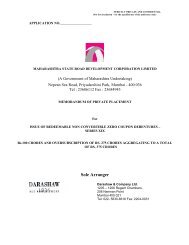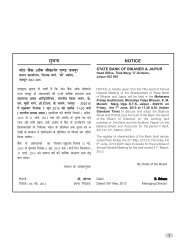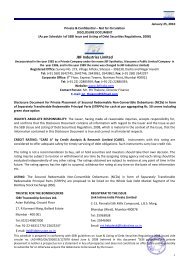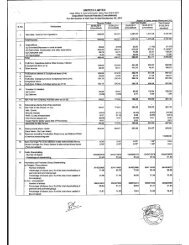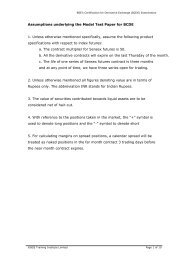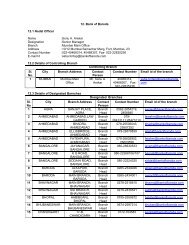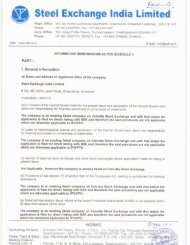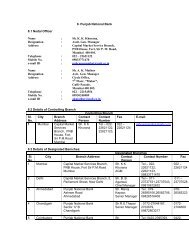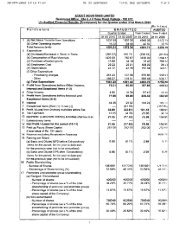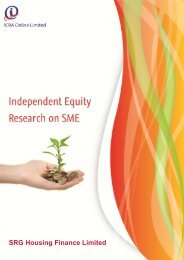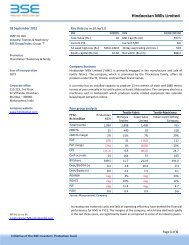EXCEL CROP CARE LIMITED C O N T E N T S - BSE
EXCEL CROP CARE LIMITED C O N T E N T S - BSE
EXCEL CROP CARE LIMITED C O N T E N T S - BSE
You also want an ePaper? Increase the reach of your titles
YUMPU automatically turns print PDFs into web optimized ePapers that Google loves.
SCHEDULE 'U' (Contd.)<br />
NOTES TO CONSOLIDATED FINANCIAL STATEMENTS<br />
(k) Inventories:<br />
Raw materials, containers,<br />
stores and spares<br />
<strong>EXCEL</strong> <strong>CROP</strong> <strong>CARE</strong> <strong>LIMITED</strong><br />
SCHEDULE FORMING PART OF THE CONSOLIDATED BALANCE SHEET AND THE CONSOLIDATED PROFIT AND LOSS ACCOUNT<br />
Lower of cost and net realisable value. However, materials and other items held for use in the production<br />
of inventories are not written down below cost if the finished products in which they will be incorporated<br />
are expected to be sold at or above cost. Cost is determined on a moving weighted average basis.<br />
Finished goods and Work-in-progress Lower of cost and net realisable value. Cost includes direct materials, labour and a proportion of<br />
manufacturing overheads based on normal operating capacity. Cost of finished goods includes excise<br />
duty. Approximately 97% of the total finished goods inventory as on 31 March 2011 has been valued on<br />
standard cost basis.<br />
Traded Goods Lower of cost and net realisable value. Cost is determined on a moving weighted average basis.<br />
Net realisable value is the estimated selling price in the ordinary course of business, less estimated cost of completion and estimated cost necessary<br />
to make the sale.<br />
(l) Revenue recognition:<br />
Revenue is recognised to the extent that it is probable that the economic benefits will flow to the Group and the revenue can be reliably measured.<br />
Sale of Goods<br />
Revenue is recognised when the significant risks and rewards of ownership of the goods have passed to the buyer. Gross turnover includes Excise Duty<br />
but does not include Sales Tax and VAT.<br />
Income from Services<br />
Revenue from service contracts are recognised pro-rata over the period of the contract as and when services are rendered and are net of service tax.<br />
Interest<br />
Revenue is recognised on a time proportion basis taking into account the amount outstanding and the rate applicable.<br />
Dividends<br />
Revenue is recognised when the shareholders’ right to receive payment is established by the balance sheet date.<br />
Royalty<br />
Revenue is recognised on an accrual basis in accordance with the terms of relevant agreement.<br />
Other Income<br />
Certain items of income such as insurance claims, overdue interest from customers and other benefits are considered to the extent the amount is<br />
ascertainable/accepted by the parties.<br />
(m) Foreign currency translations:<br />
(i) Initial Recognition<br />
Foreign currency transactions are recorded in the reporting currency, by applying to the foreign currency amount the exchange rate between the<br />
reporting currency and the foreign currency at the date of the transaction.<br />
(ii) Conversion<br />
Foreign currency monetary items are reported using the closing exchange rate on the Balance Sheet date. Non-monetary items which are<br />
carried in terms of historical cost denominated in a foreign currency are reported using the exchange rate at the date of the transaction; and<br />
non-monetary items which are carried at fair value or other similar valuation denominated in a foreign currency are reported using the exchange<br />
rates that existed when the values were determined.<br />
(iii) Exchange Differences<br />
Exchange differences arising on the settlement of monetary items or on reporting monetary items of Group at rates different from those at which<br />
they were initially recorded during the year, or reported in previous financial statements, are recognised as income or as expenses in the year<br />
in which they arise except those arising from investments in non-integral operations.<br />
(iv) Forward Exchange Contracts<br />
The premium or discount arising at the inception of forward exchange contracts is amortised as expense or income over the life of the contract.<br />
Exchange differences on such contracts are recognised in the statement of profit and loss in the year in which the exchange rates change. Any<br />
profit or loss arising on cancellation or renewal of forward exchange contract is recognised as income or as expense for the year.<br />
(n) Retirement and other employee benefits:<br />
(i) Retirement benefits in the form of Provident Fund is a defined contribution scheme and the contributions are charged to the Profit and Loss Account<br />
of the year when the contribution to the fund is due. There are no obligations other than the contribution payable to the Provident Fund Trust.<br />
(ii) Retirement benefits in the form of Superannuation Fund is a defined contribution scheme and the contribution is charged to the Profit and Loss<br />
Account of the year when the contribution accrues. There are no obligations other than the contribution payable to the Superannuation Fund<br />
Trust. In case of the Holding Company, the scheme is funded with Insurance Company in the form of a qualifying insurance policy.<br />
(iii) Gratuity liability is a defined benefit obligation and is provided for on the basis of an actuarial valuation on projected unit credit method made<br />
at the end of each financial year. In case of the Holding Company, the scheme is funded with Insurance companies in the form of qualifying<br />
insurance policies.<br />
82



